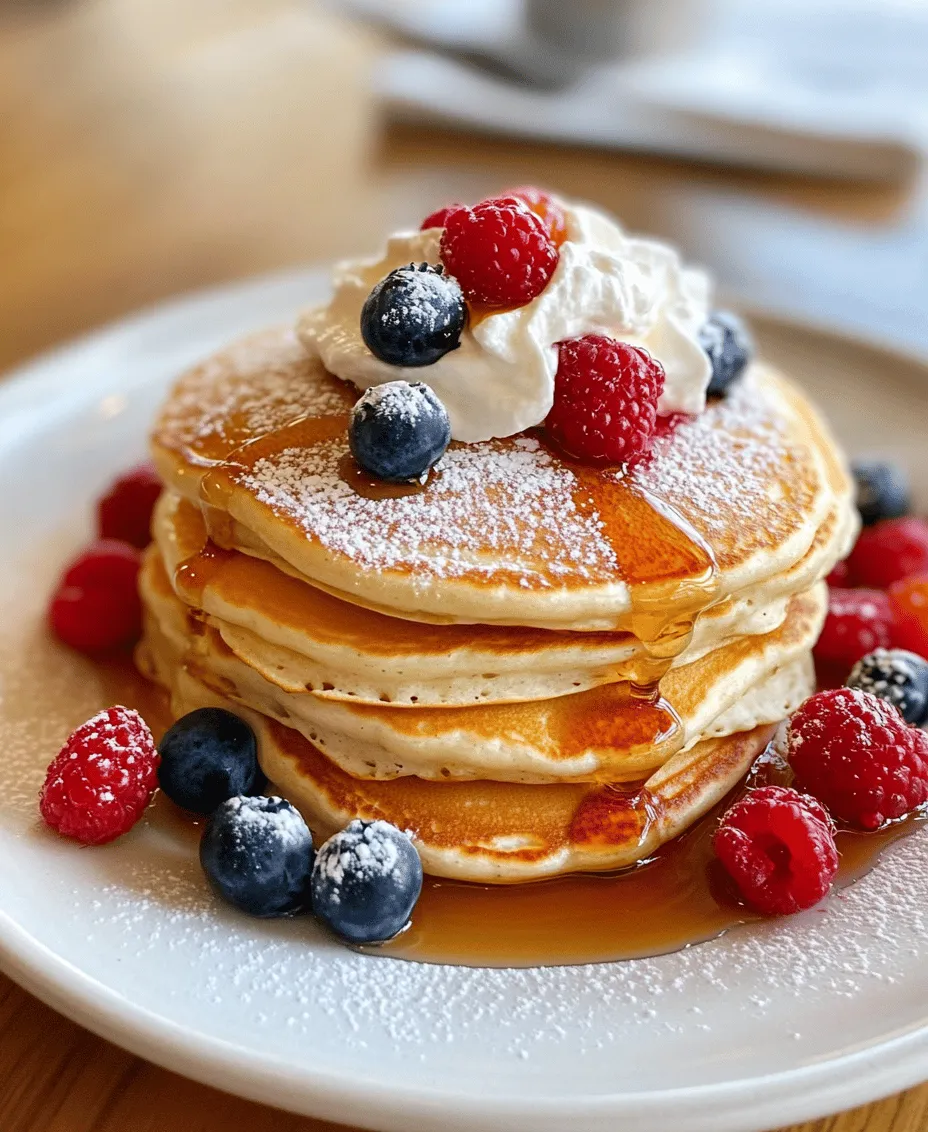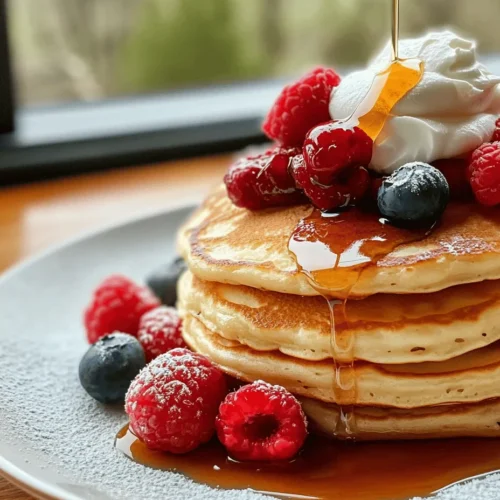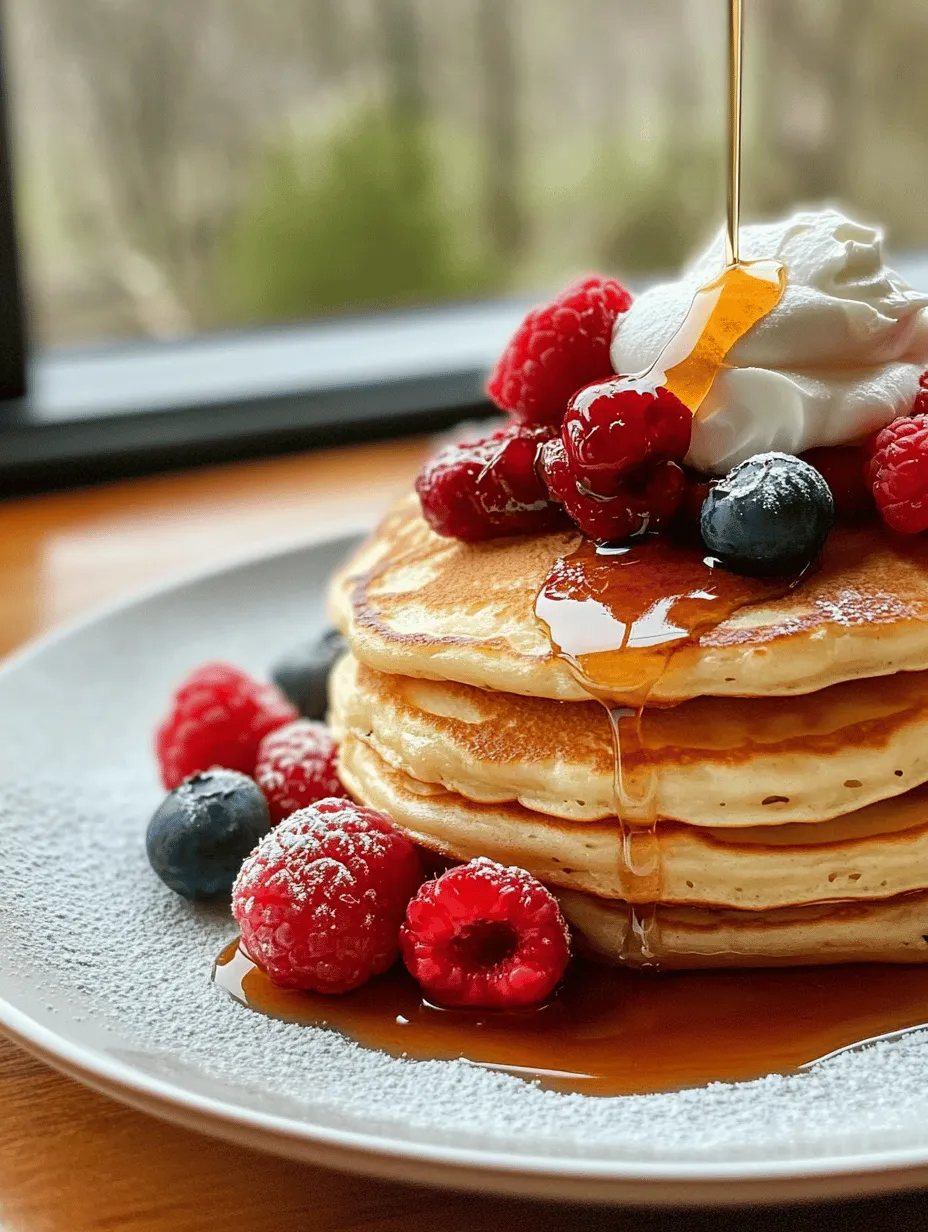Introduction
There’s something magical about waking up to the smell of freshly cooked pancakes wafting through the kitchen. Homemade pancakes evoke a sense of nostalgia, often reminding us of lazy Sunday mornings and family gatherings. Fluffy pancakes, in particular, hold a special place in breakfast culture around the world. From classic American breakfasts to brunches in cozy cafes, their light and airy texture is a delight that many of us cherish.
In this article, we’ll dive deep into the art of making fluffy pancakes, revealing techniques, tips, and variations that will elevate your breakfast game. Whether you’re a novice in the kitchen or a seasoned home chef, you’ll find valuable insights that will help you create the ultimate pancake experience. So, let’s get started on this delicious journey!
Understanding Pancake Ingredients
Before we jump into the preparation steps, it’s essential to understand the key ingredients that come together to create fluffy pancakes. Each component plays a crucial role in achieving that desirable texture and flavor.
All-Purpose Flour: The Foundation of the Pancake
All-purpose flour is the cornerstone of any pancake recipe. Its balanced protein content provides the structure that pancakes need to rise and hold their shape. When selecting flour, opt for a high-quality brand to ensure consistency in your pancake batter. The gluten in the flour helps trap air bubbles during cooking, contributing to that fluffy texture we all love.
Sugar: Adding Sweetness and Color
Sugar does more than sweeten your batter; it also enhances the browning of the pancakes, giving them a beautiful golden hue. Granulated sugar is commonly used, but you can experiment with brown sugar for a deeper flavor. A little sugar goes a long way, so adjust to your taste preference.
Baking Powder: The Leavening Agent for Fluffiness
Baking powder is the secret to achieving that light and airy quality in your pancakes. As a leavening agent, it releases carbon dioxide gas when mixed with wet ingredients, causing the batter to rise during cooking. For optimal results, ensure your baking powder is fresh; old baking powder can lead to flat pancakes.
Salt: Enhancing Flavors
Though it may seem counterintuitive, salt is essential in enhancing the overall flavor of your pancakes. A small pinch balances the sweetness and brings out the richness of the other ingredients. Don’t skip this step, as it can make a significant difference in taste.
Milk: The Role of Moisture in the Batter
Milk adds moisture to the batter, creating a smooth consistency. It also assists in dissolving the dry ingredients, leading to a well-combined mixture. You can use whole milk for richer pancakes or low-fat milk for a lighter option. For dairy-free alternatives, almond milk or oat milk can work just as well.
Eggs: Binding and Providing Structure
Eggs are crucial for binding the ingredients together and providing structure to the pancakes. They help create a tender texture while adding richness. Be sure to use large eggs, as they are standard in most recipes. If you’re looking for a vegan alternative, consider using a flaxseed meal or applesauce as a substitute.
Butter: Adding Richness and Flavor
Melted butter adds a rich flavor and contributes to the pancake’s tenderness. It also helps create a golden crust on the surface when cooked. For a healthier alternative, you can use coconut oil or a non-dairy spread. Just ensure that whatever fat you choose is melted and slightly cooled before mixing it into the batter.
Vanilla Extract: A Hint of Aromatic Sweetness
Vanilla extract is the finishing touch that elevates the flavor profile of your pancakes. A splash of vanilla adds warmth and depth, making your pancakes taste even more delicious. Opt for pure vanilla extract for the best flavor, although imitation vanilla can also work in a pinch.
Discussion on Optional Ingredients and Toppings
While the above ingredients are essential for basic fluffy pancakes, you can customize your recipe with optional ingredients. Consider adding chocolate chips, blueberries, or nuts to the batter for extra flavor and texture. These additions can transform your pancakes into a gourmet breakfast treat.
When it comes to toppings, the possibilities are endless. Fresh fruits like strawberries, bananas, or raspberries can add a refreshing touch, while whipped cream or maple syrup provides that classic pancake experience. If you’re feeling adventurous, try adding a dollop of yogurt or a sprinkle of cinnamon for an extra flavor boost. Remember, choosing quality toppings can elevate your pancake experience from ordinary to extraordinary.
The Science Behind Fluffy Pancakes
Understanding the science behind pancake preparation can help you perfect your technique. Each ingredient interacts with one another to create that fluffy texture we strive for.
The Role of Mixing and the Importance of Not Overmixing
When it comes to mixing your pancake batter, less is more. Overmixing can develop the gluten in the flour, resulting in dense and chewy pancakes rather than light and fluffy ones. Mix your dry ingredients separately from the wet ones, then gently combine them until just incorporated. A few lumps in the batter are perfectly acceptable and will work themselves out during cooking.
Understanding the Cooking Process: Heat and Timing for Perfect Pancakes
Cooking pancakes requires the right balance of heat and timing. Preheat your skillet or griddle to medium heat, allowing it to become hot enough to create a golden crust without burning. If the heat is too low, your pancakes will absorb moisture and turn out soggy. Conversely, too high of a temperature will result in burnt edges and raw centers.
Once you pour the batter onto the cooking surface, keep an eye on the bubbles forming on the top. When the edges start to look set and bubbles appear across the surface, it’s time to flip your pancakes. This technique ensures even cooking and a beautiful rise.
Step-by-Step Pancake Preparation
Now that we understand the ingredients and the science behind them, let’s move on to the step-by-step preparation of our fluffy pancakes.
Mixing Dry Ingredients: Importance of Thoroughness
1. Gather Your Ingredients: Start by gathering all your ingredients and measuring them accurately. Precision is key to achieving the best results.
2. Combine Dry Ingredients: In a large mixing bowl, combine 1 cup of all-purpose flour, 2 tablespoons of granulated sugar, 1 tablespoon of baking powder, and a pinch of salt. Whisk these dry ingredients together thoroughly. This step ensures even distribution of the leavening agent and sugar, which is essential for uniform pancakes.
3. Create a Well: After mixing the dry ingredients, create a small well in the center of the mixture. This will make it easier to incorporate the wet ingredients without overmixing.
4. Set Aside: Once your dry ingredients are well combined, set the bowl aside while you prepare the wet ingredients.
In the next section, we will delve into the preparation of the wet ingredients and how to combine everything for the perfect pancake batter. Stay tuned for the continuation of this delightful pancake adventure!

Combining Wet Ingredients: Techniques for Best Results
To achieve the light and airy texture that defines fluffy pancakes, it’s crucial to combine the wet ingredients properly. Start by measuring out your liquids—typically milk, eggs, and melted butter—before mixing them in a separate bowl. This ensures even distribution of ingredients and prevents clumping. For optimal results, whisk the eggs until they are light and frothy before adding them to the milk. This aeration helps to incorporate air, contributing to the fluffiness of the final product.
When adding melted butter, ensure it’s not too hot; otherwise, it could cook the eggs and create a scrambled texture. If you’re using buttermilk, which is often recommended for achieving that extra fluffiness, allow it to come to room temperature before combining it with the other wet ingredients. This will help maintain a consistent batter temperature, leading to more evenly cooked pancakes.
Merging Mixtures: Tips for Maintaining Fluffiness
Once your wet ingredients are well mixed, it’s time to combine them with the dry ingredients. It’s essential to do this gently to preserve the air already incorporated into the batter. Using a spatula or wooden spoon, fold the wet ingredients into the dry ingredients until just combined. Avoid vigorous stirring; overmixing can lead to dense pancakes due to gluten development. The batter should have a few lumps remaining, as this indicates that it hasn’t been overworked.
If you notice your batter is too thick, it’s acceptable to add a splash of milk to achieve your desired consistency. However, remember that a slightly thicker batter often results in fluffier pancakes, so aim for a balance.
Preheating the Skillet: Optimal Temperatures for Cooking
Preheating your skillet is one of the most critical steps in pancake preparation. Ideally, a non-stick skillet or griddle should be heated over medium-low to medium heat. A good test for skillet readiness is to sprinkle a few drops of water on the surface; if they sizzle and evaporate quickly, the skillet is ready.
Using the right temperature is crucial; too high will cause the outside of the pancake to burn before the inside cooks through, while too low will result in flat, greasy pancakes. Once the skillet is preheated, add a small amount of butter or non-stick spray to ensure your pancakes don’t stick to the surface.
Cooking Technique: Signs to Look for When Flipping Pancakes
Cooking pancakes is as much about timing as it is about technique. Pour a ladleful of batter onto the hot skillet, and let it cook undisturbed. Watch for bubbles to form on the surface of the pancake. This is a sign that the pancake is ready to be flipped. When you see bubbles that stay open and the edges look set, it’s time to turn it over.
Use a spatula to gently lift the pancake’s edge and check for a golden-brown color before flipping. Cook the second side for about half the time of the first side, usually one to two minutes. A perfectly cooked pancake will be fluffy, golden, and slightly crispy on the outside.
Serving Suggestions: Creating a Beautiful Presentation
Presentation is key when serving fluffy pancakes. Stack your pancakes high on a plate for an impressive display. For added flair, consider alternating layers with toppings such as sliced fruits, whipped cream, or a sprinkle of nuts. Drizzle maple syrup or chocolate sauce over the top, allowing it to cascade down the sides for an enticing visual.
To elevate your pancake serving further, add a dusting of powdered sugar or a dollop of yogurt on the side. Fresh herbs like mint or a sprinkle of cinnamon can also add a pop of color and flavor. Remember, the more visually appealing your dish is, the more enjoyable the eating experience will be.
Common Mistakes to Avoid
Overmixing the Batter: One of the most common errors when making pancakes is overmixing the batter. While it may be tempting to smooth out every lump, doing so can lead to the development of gluten, resulting in chewy rather than fluffy pancakes. Aim for a batter that is mixed just enough to bring the ingredients together while still retaining some lumps.
Incorrect Skillet Temperature: Using a skillet that is either too hot or too cold can ruin your pancakes. If the skillet is too hot, the outside will burn before the inside cooks; if it’s too cold, the pancakes can end up greasy and flat. Maintaining medium to medium-low heat is critical for achieving that perfect golden-brown finish.
Skipping the Resting Period: Allowing the batter to rest for about 10-15 minutes is crucial. This resting period lets the flour fully hydrate and the gluten relax, resulting in a lighter texture. Skipping this step can lead to denser pancakes that lack the desired fluffiness.
Using the Wrong Type of Pan: The type of pan you use can significantly affect the outcome of your pancakes. A non-stick skillet is preferred for pancakes as it allows for easy flipping and reduces the risk of sticking. If you are using a regular skillet, make sure it is well-greased beforehand to avoid any mishaps.
Variations on the Classic Fluffy Pancakes
Exploring Different Types of Pancakes: While the classic fluffy pancake is a breakfast staple, there are numerous variations worth exploring. Each type has its unique flavor and texture, allowing you to customize your breakfast experience.
Buttermilk Pancakes: Buttermilk pancakes are renowned for their extra fluffiness, thanks to the acidity of the buttermilk, which reacts with baking soda to create lighter pancakes. This variation is perfect for those who enjoy a tangy flavor alongside their sweetness.
Whole Wheat Pancakes: For a healthier alternative, consider making whole wheat pancakes. By substituting all-purpose flour with whole wheat flour, you’ll add more fiber and nutrients to your meal. Whole wheat pancakes can be just as fluffy when prepared correctly.
Vegan Pancakes: If you’re looking for a plant-based option, vegan pancakes are an excellent choice. Substitute eggs with mashed bananas or applesauce and use almond milk or soy milk instead of dairy. These pancakes can be just as fluffy and delicious while catering to dietary preferences.
Creative Flavor Additions: There’s no limit to the creative additions you can make to your pancake batter. Consider mixing in chocolate chips, nuts, or spices like cinnamon for a unique twist. For fruit lovers, try infusing your batter with mashed bananas or blueberries for a refreshing flavor.
Pairing Pancakes with Delicious Toppings
Traditional Toppings: No pancake breakfast is complete without delicious toppings. Maple syrup is the classic choice, providing a sweet contrast to the fluffy pancakes. A pat of butter melting on top enhances the richness, and a light dusting of powdered sugar can add an elegant touch.
Healthy Options: For those who prefer a healthier approach, consider using Greek yogurt paired with fresh fruits like berries or bananas. Nut butters, such as almond or peanut butter, can also add a rich, satisfying flavor while providing protein.
Indulgent Choices: If you’re in the mood for something more decadent, think about whipped cream, chocolate sauce, or caramel drizzled over your pancakes. These toppings can transform a simple breakfast into a special occasion treat.
Conclusion
Fluffy pancakes are not only a breakfast favorite but also a versatile dish that invites experimentation with flavors and toppings. From classic buttermilk to whole wheat and vegan variations, the possibilities are endless. The joy of making pancakes from scratch lies in the ability to customize each batch to suit your tastes.
As you prepare your fluffy pancake delight, don’t hesitate to experiment with different ingredients and toppings. Whether you’re serving them for a leisurely weekend brunch or a quick weekday breakfast, the satisfaction of creating something delicious from scratch is unmatched. Embrace your culinary creativity and enjoy every fluffy bite!



